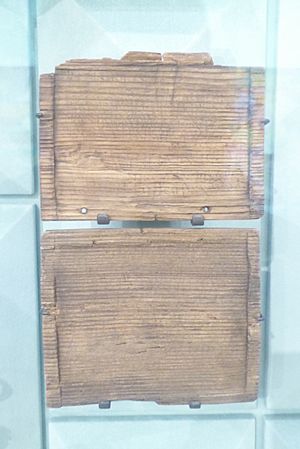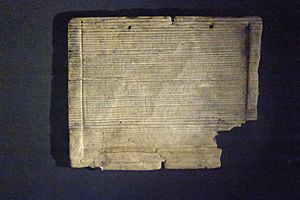Bloomberg tablets facts for kids
The Bloomberg tablets are a special collection of 405 old wooden tablets. They were found deep underground in the financial heart of London. These tablets are super important because they are the oldest written documents ever found in Britain! They date back to 50 to 80 AD, which was during the early Roman period. This means they are even older than the famous Vindolanda tablets.
Contents
Finding the Ancient Tablets
The Bloomberg tablets were discovered during a big digging project. This happened between 2010 and 2013. The dig was to prepare for building the new Bloomberg building. The site was once part of Londinium, a busy Roman city.
Archaeologists had found a Roman temple there before. But a large office building was built on top in 1953. When that building was taken down in 2010, archaeologists got another chance to explore. They found many amazing things, including the tablets. The tablets were buried about 40 feet (12 meters) underground.
Finding wooden tablets was a big surprise! Wood usually rots away over time. But these tablets were saved by thick, wet mud. This mud came from an underground river called the River Walbrook. The mud kept oxygen away from the wood. This helped the tablets stay preserved for nearly 2,000 years.
When found, the tablets were very wet. Workers carefully cleaned them with water and soft brushes. This made sure the old writing was not damaged.
How Were These Tablets Made?
The tablets were originally made of wood and wax. Only the wood part survived. A typical tablet was a thin piece of wood. It was about 15–25 cm (6-10 inches) wide. A rectangular dip was carved into its center.
Warm beeswax was poured into this dip. A dark color was added to the wax. Once the wax cooled, people used a metal stylus to scratch letters into it. The scratches would show a lighter color against the dark wax.
These wax tablets could also be used again. If you heated the tablet, the wax would soften. Then it would become smooth again for new writing. The wood for the tablets likely came from old barrel parts. Many tablets were made in a "diptych" style. This means two tablets were loosely connected. They could fold together like a small book. This protected the soft wax inside.
Reading the Old Messages
Recreating the Writing
The wax from the tablets is gone. But tiny scratches were left on the wood. These scratches helped experts figure out what was written. You might not see these scratches with your eyes. But special technology can help.
To recreate the writing, many photos were taken. Each photo used different light angles. This created different shadows on the tablet's surface. When put together, these pictures showed the exact shape of the scratches. This let experts see the old messages. Sometimes, tablets were reused many times. This means several messages might be on top of each other. This makes them harder to read!
What the Tablets Say
So far, 90 of the Bloomberg tablets have been translated. This is the most from any Roman site in London! Another 91 tablets have writing but are too hard to read.
The translated tablets tell us many things:
- 43 tablets are general letters.
- 25 are about money or legal matters.
- 8 are bookkeeping records, showing who owed what.
- The other 14 are various other notes.
Dr. Roger Tomlin translated the tablets. He is an expert in Roman cursive, which was the writing style used.
The tablets contain amazing information. One has the oldest financial document from London. It dates to January 8, 57 AD. This was a few years before the city was attacked by Boudica. Other tablets include legal papers, like a judge calling a meeting. There's even a tablet with the alphabet written out. This might be proof of Britain's first school!
More than 100 names of people are also found. They were from all walks of life in Roman London. This includes slaves, merchants, soldiers, and politicians. One important person named is Julius Classicus, a Roman commander.
One tablet has the very first mention of the name "London." This is much earlier than historians thought! Another tablet says that Verulamium sent supplies to London. Before, people thought it was the other way around.
Keeping Them Safe
Many tablets are still unreadable. So, experts are working hard to keep them safe. This way, future scientists can study them. They use a mix of special liquids and freeze-drying. This helps preserve the wood.
Where to See Them
Some of the tablets are on display. You can see them at the "London Mithraeum" museum. This museum is located in the Bloomberg European Headquarters. It opened in November 2017.
See also



